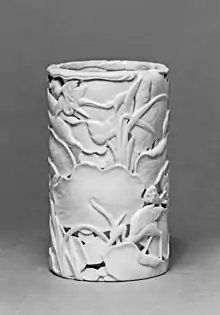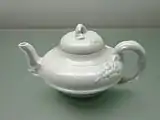Hokkien culture
Minnan culture or Hokkien/Hoklo culture (Hokkien Pe̍h-ōe-jī: Bân-lâm bûn-hòa; Chinese: 閩南文化), also considered as the Mainstream Southern Min Culture, refers to the culture of the Hoklo people, a group of Han Chinese people who have historically been the dominant demographic in the province of Fujian (called "Hokkien" in the Hoklo language) in Southern China, Taiwan, Singapore, and certain overseas Chinese communities in Southeast Asia.
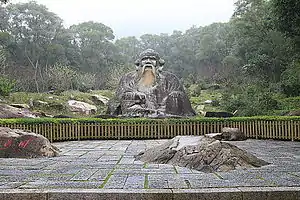
This culture has been influenced by the cultures from Minyue (a branch of Baiyue people who inhabited Hokkien before sinicization of the region), China's Central Plain (most notably during Tang Dynasty and Song Dynasty), and Japan (due to Taiwan being a former Japanese colony).[1][2][3] It encompasses the Hoklo language and its associated architecture, folk arts, cuisines, and large amount of folklore. Since 17th century, Hokkien culture has spread with Hoklo immigration to Taiwan, Singapore, and Southeast Asia. Its influence today can be seen in Taiwanese pop culture, resulting in it becoming an influential cultural force in Taiwan, Southern Fujian and Southeast Asia.
The province of Fujian itself shows considerable linguistic and cultural diversity – Min Chinese languages, spoken across Fujian, have several dialects that have at best limited mutual intelligibility with one another.[4] The focus of this article is on the culture of southern Fujian (around the cities of Amoy and the two cities named Chinchew), the area where the Southern Min/Hoklo language is spoken, and also by far the most populous part of Fujian.
Native language
Southern Min (Chinese: 閩南語; Pe̍h-ōe-jī: Bân-lâm-gú), also called the Hokkien language, Hoklo language, Hokkien-Taiwanese or Min-Nan, belongs to the Min Chinese subgroup of Chinese language family and is an isolating language. It is the product of the language spoken by the original Minyue people and that of the later arriving Han Chinese. A large number of Han Chinese people migrated to Southern Fujian between 7th to 13th century from Northern China, which was then invaded by various non-Han ethnic groups such as the Mongols,[5] and intermixed with Minyue people. The intermixing is reflected by the fact that:
- Modern day Hoklo people are, genetically, the hybrid descendants of Minyue and Ancient Han Chinese;[6]
- And that modern Hokkien language shows traits of both the Minyue language and Old Chinese.[7][8]
Due to the historic migration of Hoklo people to Taiwan and Southeast Asia, the Hokkien language has spread far beyond its traditional homeland of Southern Fukian. In each of these areas, local forms of Hokkien can be found and show influences from nearby languages. Taiwanese Southern Min, for instance, has been influenced by Japanese and Formosan languages (languages spoken by Taiwanese aboriginals), while Singaporean Hokkien contains many loanwords from Malay and English. Philippine Hokkien on the other hand, showcases a few loanwords from Spanish or Filipino and is regularly code-switched with English, Filipino/Tagalog, and/or Visayan languages, as well as other Philippine languages. These various forms of Hokkien are, however, still similar enough to be largely mutually intelligible with one another.[9]
Writing system

In terms of writing systems, Hokkien gained one as early as the first half of 16th century (Ming Dynasty) - with the play Tale of the Lychee Mirror (Chinese: 荔鏡記; Pe̍h-ōe-jī: Nāi-kèng-kì),[10] which is fairly popular among Hoklo people even to this day. Later in 18th century, Koa-á books, a form of vernacular Hokkien literature, gained popularity and attempted to use Chinese characters to write the Hokkien language. Written Hokkien saw further development in 19th century. At that period, Presbyterian Christian sought to spread Presbyterianism in the Hokkien region and devised the "Pe̍h-ōe-jī" - a Hokkien writing system that uses Latin alphabets - in Amoy (known as "Xiamen" in Mandarin), Hokkien.
Japan, while colonizing Taiwan, also developed the Taiwanese kana writing system.[11]
Architecture
The traditional architectural style of Hoklo people is largely similar to those of surrounding Han Chinese groups. There are, however, several features that are unique or mostly unique to Hoklo-made buildings, making many traditional buildings in Hokkien and Taiwan visually distinctive from those outside the region. Traditional Hokkien architecture has been noted for: (1) Swallowtail roof (Pe̍h-ōe-jī: ìnn-bé-tsiah; Traditional Chinese: 燕尾脊, literally "swallowtail ridge"), which refers to a roof that has an upward-curving ridge shaped like the tail of a swallow. The degree of curving may vary. The "swallowtail" in question can be single- or double-layered and is typically decorated with a large amount of colorful carvings;[12][13] (2) Cut porcelain carving (Chinese: 剪瓷雕; Pe̍h-ōe-jī: Tsián-huî-tiau), which is seen also in Vietnamese architecture[14][15] - Traditionally, Hoklo porcelain artists gather small, colored porcelain artifacts, cut and grind them into small fragments, and then paste these fragments onto sculptures attached to buildings. This art is frequently used on the ridges, window frames, and doors of temples and larger residence, often together with swallowtail roof.
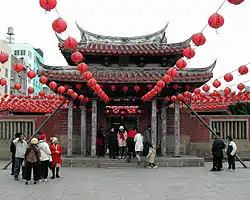 Typical Hoklo architecture styled Lukang Longshan Temple in Lukang city.
Typical Hoklo architecture styled Lukang Longshan Temple in Lukang city.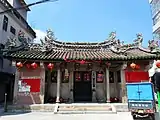

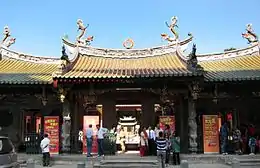 Front entrance of Thian Hock Keng Temple, Singapore.
Front entrance of Thian Hock Keng Temple, Singapore.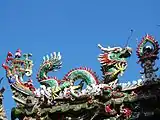 A Chinese dragon sculpture on the roof of Amoy Memorial Temple of Lord Guan, Amoy, Hokkien; It is an example of cut porcelain carvings.
A Chinese dragon sculpture on the roof of Amoy Memorial Temple of Lord Guan, Amoy, Hokkien; It is an example of cut porcelain carvings.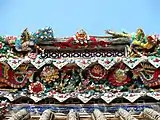 Cut porcelain carving decorations above the main door of Nanfeng Ancestral Temple.
Cut porcelain carving decorations above the main door of Nanfeng Ancestral Temple.
Têng-á-kha
Têng-á-kha (Chinese: 亭仔跤; Pe̍h-ōe-jī: Têng-á-kha) is a style of architecture found in much of Southern China and roughly the Hokkien counterpart of Cantonese tong lau. It is a style that incorporates elements from Western European architecture, arising slowly in late 18th century due to the contact with Western European colonization in Southeast Asia. A typical têng-á-kha has a ground floor used for running some sort of business (such as a grocery store) and upper floors that are used for residential purpose. Amoy's têng-á-khas are said to be marked by having pink and white as main colorings, use of streets full of têng-á-khas as markets, and distribution of têng-á-khas in net-like structures.[16] The city of Chinchew has also been noted to have a well-preserved set of têng-á-khas.[17]
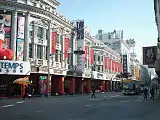 Zhongshan Road, Amoy, is filled with têng-á-khas.
Zhongshan Road, Amoy, is filled with têng-á-khas.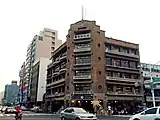 The Hayasi Department Store in Tainan, Taiwan, is also considered a good example of têng-á-kha.
The Hayasi Department Store in Tainan, Taiwan, is also considered a good example of têng-á-kha.
Visual arts
Hua'an jade
Hua'an jade (Pe̍h-ōe-jī: Hua-an gi̍k; Traditional Chinese: 華安玉) is a type of hornfels with green bands consisting of epidote and diopside, known to be found primarily in Hokkien, China. It is noted for being dense, resistant to wearing, and having very irregular coloring and texture.[18] This type of jade is frequently used in jewellery and carvings made in Hokkien.
Tek-hòe porcelain
Tek-hòe porcelain (Pe̍h-ōe-jī: Tek-hòe hûi; Traditional Chinese: 德化陶瓷) is a type of white porcelain that originated from the city of Tek-hòa (called "Dehua" in Mandarin Chinese), Hokkien. This style of porcelain began in 14th to 15th century (Ming Dynasty), and, according to some sources, perhaps even earlier than that.[19] This style is noted for using Kaolinite to create very detailed and delicate porcelains, and also for the products' pure, ivory-like white coloring and resemblance to archaic ritual objects. With the Hokkien coast being a major ceramic exporting center at that time, Tek-hòe porcelain products have been sold to Western European merchants and given the name "Blanc de Chine" (literally "White of China") by the French.[20] Even in the 21st century, Hoklo people are still keeping the tradition of making Tek-hòe porcelain alive, and this style is used in many types of products, ranging from purely artistic ones (e.g., sculptures) to more practical ones (e.g., eating utensils).
Gallery
Minnan style of calligraphy
Hoklo people have also used a considerable amount of calligraphy as decorations for their traditional buildings.[21] The potential of Minnan style of calligraphy (Pe̍h-ōe-jī: Bân-lâm su-hong; Traditional Chinese: 閩南書風) has come under the attention of Chinese cultural scholars in late 2000s. Deeper studies are being conducted on the traditional calligraphy of Hokkien.[22]
Lacquer thread sculpture
Lacquer thread sculpture (Pe̍h-ōe-jī: Tshat-suànn tiau; Traditional Chinese: 漆線雕, literally "painted wire carving"), sometimes translated as "paint line carving" in English, is a traditional folk art in Hokkien, having originated in Amoy before 18th century. This folk art involves wrapping fine, usually golden filigree-like threads around other artifacts to form images of characters and animals. It is most typically used on Buddhist statues and vases for the purpose of decoration.[23] It was traditionally passed only to male heirs but is now passed to Hoklo of either gender. As of 2006, it has formally been declared an intangible cultural heritage by China.
A video of the process of making lacquer thread sculpture (in Mandarin) is available on YouTube.
Minnan school of painting
Minnan school of painting (Pe̍h-ōe-jī: Bân-lâm uē-phài; Traditional Chinese: 閩南畫派) is a school of painting invented by Hoklo people in Hokkien.[24] It was invented in mid-20th century by a group of Hoklo painters in Chinchew, Hokkien. This style was characterized by a strong urge to break conventions in traditional Han Chinese paintings and adoption of modern European artistic ideals. It has been influenced by impressionism, fauvism, and cubism, but retained many techniques used in traditional Han Chinese paintings.[25] Despite being rather obscure outside Hokkien, it has seen an increase in popularity among Hoklo in early 21st century.[26]
Others
Performing arts
Hoklo have historically been prolific producers of music and operas, most of which are sung and expressed using the Hokkien language. Music and opera types that originated in or are associated with the Hokkien-speaking region include:
- Lâm-kóan music (Pe̍h-ōe-jī: Lâm-kóan; Traditional Chinese: 南管, literally "southern pipes");
- Pak-kóan music (Pe̍h-ōe-jī: Pak-kóan; Traditional Chinese: 北管, literally "northern pipes");
- Phô͘-sian opera (Pe̍h-ōe-jī: Phô͘-sian-hì; Traditional Chinese: 莆仙戲, literally "opera of Phô͘-sian");
- Lê-hn̂g opera (Pe̍h-ōe-jī: Lê-hn̂g-hì; Traditional Chinese: 梨園戲, literally "pear garden opera");
- Ko-kah opera (Pe̍h-ōe-jī: Ko-kah-hì; Traditional Chinese: 高甲戲, literally "tall-armor opera");
- Tap-chhùi-kó͘ (Pe̍h-ōe-jī: Tap-chhùi-kó͘; Traditional Chinese: 答嘴鼓, literally "replying and drum");[27]
- Taiwanese opera (Pe̍h-ōe-jī: Koa-á-hì; Traditional Chinese: 歌仔戲, literally "song-opera");
- Hokkien pop (Pop music produced mainly in Taiwan and in the Hokkien language);
Glove puppetry
Glove puppetry (Pe̍h-ōe-jī: Pò͘-tē-hì; Traditional Chinese: 布袋戲, literally "cloth bag opera") is by far the best-known opera form of Hokkien origin. It originated in Hokkien in around 17th century, and is a form of opera that uses cloth puppets and music to tell stories. Puppets used in glove puppetry have hollow heads carved with wood. Their palms and feet are also made of wood, but the torso and limbs consist entirely of cloth costumes. During a performance, a gloved hand enters the puppet's costume and make it move. The puppets used in these shows used to strongly resemble cloth sacks, hence the name "cloth bag opera".
- Glove puppetry
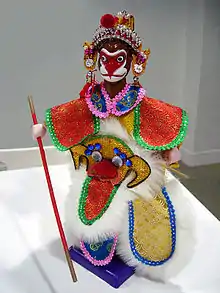 A Sun Wukong puppet used in glove puppetry; Glove puppetry is a form of opera that uses cloth puppets.
A Sun Wukong puppet used in glove puppetry; Glove puppetry is a form of opera that uses cloth puppets.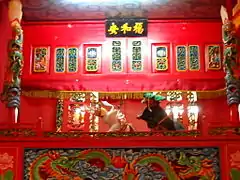 A glove puppetry performance
A glove puppetry performance
Literature
Food culture
Hokkien cuisine
Tea culture
Martial arts
Philosophy
Min school
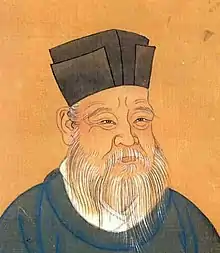
Min school (Pe̍h-ōe-jī: Bân-ha̍k; Traditional Chinese: 閩學) is a Neo-confucian school founded primarily by Hoklo scholars, with the Hokkien-born Gonin Tsu Hi being the leading figure.[28] The Min school is said to be marked by (1) an emphasis on the Four Books: the Great Learning, the Doctrine of the Mean, the Analects of Confucius, and the Mencius; (2) a tendency to interpret Buddhism from the lens of Confucianism; (3) placing importance on self-perfection. Philosophy of the Min school was passed to Korea and Japan through cultural exchange during the Ming Dynasty.
Traditional celebrations
Religions
Chinese folk religion & Taoism
The Hokkien have great devotion to Jade Emperor, who commands all Heavenly Deities and Earthly beings. They will conduct grand worship service on the 9th day of first lunar month as the birthday of Jade Emperor. [29]
Other popular Chinese deities are Mazu, Siong Teh Gong, Bao Sheng Da Di, Guan Teh Gong, Kuan Yim Hood Chor, Ong Yah Gong, Qing Shui Zhu Shi, Kai Zhang Sheng Wang, Fu De Zheng Shen.
Science and inventions
Shipbuilding
The Minyue people - the original inhabitants of Hokkien before sinicization of the region - were known for their skills in shipbuilding. Even the ancient Han Chinese, who were, by a considerable margin, the most advanced people in the region at that time, took note of Minyue's shipbuilding skills.[30][31] For most of the first millennium AD, Port of Meizhou Bay of Chinchew has been one of the greatest ports of the Chinese Empire. Later, during 6th to 9th century (Tang dynasty), peoples in Hokkien were said to be able to build large ships of 50 to 60 tonnes, which was very remarkable for that time period.[32] Hokkien remained the leading shipbuilding center for the Chinese Empire in the six centuries that followed, resulting in a strong shipbuilding tradition among Hoklo.[33]
Cultural symbols
See also
- Index of Taiwan-related articles
- Index of Singapore-related articles
- Southern Min Wikipedia
- Hui'an maidens
Hokkien customs
Related cultures
References
- Zheng, Y. (2010). On the Unique Features of Minnan Culture and its Ecological Conservation [J]. Journal of Fujian Normal University (Philosophy and Social Sciences Edition), 1.
- Su, Z. F., & Wang, J. S. (2008). The Maritime Characteristic of Minnan Culture and Its Function to the West-strait Economy [J]. Journal of Fujian School of Administration and Fujian Institute of Economics and Management, 1, 018.
- 顧炎武(清). 《天下郡國利病書》:郭造卿《防閩山寇議》. 上海書店. 1985.
- Wang, W. S. Y., & Sun, C. (Eds.). (2015). The Oxford handbook of Chinese linguistics. Oxford Handbooks.
- 董忠司 (編). 《福爾摩沙的烙印:臺灣閩南語概要》(上冊). 鄉土文化專輯 1. 台北市: 行政院文化建設委員會. 2001年12月1日.
- Brindley, E. F. (2015). Ancient China and the Yue: Perceptions and Identities on the Southern Frontier, c. 400 bce–50 ce. Cambridge University Press.
- Norman, Jerry (1988), Chinese, Cambridge: Cambridge University Press, ISBN 978-0-521-29653-3.
- Ting, Pang-Hsin (1983). "Derivation time of colloquial Min from Archaic Chinese". Bulletin of the Institute of History and Philology. 54 (4): 1–14.
- "中研院尋獲閩南語重要詞彙文獻 400年前就有「洗門風」 - 生活 - 自由時報電子報". news.ltn.com.tw. Retrieved 2018-12-05.
- Chappell, Hilary; Peyraube, Alain (2006). "The analytic causatives of early modern Southern Min in diachronic perspective". In Ho, D.-a.; Cheung, S.; Pan, W.; Wu, F. Linguistic Studies in Chinese and Neighboring Languages. Taipei: Institute of Linguistics, Academia Sinica. pp. 973–1011.
- Ogawa Naoyoshi, ed. (1931). 臺日大辭典 [Taiwanese-Japanese Dictionary] (in Japanese and Chinese). Taihoku: Governor-General of Taiwan.
- 曹春平. 《闽南传统建筑》. 中國: 厦门大学出版社. 2006-06.
- 福建省炎黄文化研究会、中国人民政治协商会议、泉州市委会. 《闽南文化研究》第2卷. 中國: 海峽文艺出版社.
- 許東生. 《潮汕嵌瓷工藝研究:以存心善堂為例》. 美術學報. 2011年4月.
- 陳磊. 《閩南民間藝術奇葩-剪瓷雕》. 南京藝術學院學報. 2009年6月.
- 近代廈門舊城改造規劃實踐及思想(1920-1938年).李百浩,嚴昕.城市規劃學刊.2008年第3期
- 泉州中山路正式掛牌 「中國十大歷史文化名街」.泉州晚報.
- Wu Rongbiao (2009): Preliminary Study of the Ore-Forming Mechanism of the Hua'an Jade Deposit in Jiubaoqu of Nanjing County, Fujian Province. Geology of Fujian 28(2), 115-118 (in Chinese).
- 閩南民間手藝瓷雕塑——德化名瓷 瓷國明珠
- Donnelly, P.J. (1969). Blanc de Chine, Faber and Faber, London.
- 閩南書法大觀園——蔡氏古民居建築群書法藝術簡述
- 从闽南书风·厦门书法看地域文化与书法艺术的关系
- 漆线雕艺术
- 闽南画派 三十而立
- Cohen, J. L. (1987). The new Chinese painting, 1949-1986.
- “京城新传统”对话“闽南画派”
- 答嘴鼓的表演形式. 中國曲藝志·福建卷. 北京: 中國ISBN中心. 2006. ISBN 7507602699.
- The Theoretical Characteristics and Cultural Significance of Min School
- "THIAN HOCK KENG - TRADITIONS AND CULTURES". thianhockkeng.com.sg/. Retrieved 19 December 2020.
- 《漢書 · 嚴助傳》:「(閩)越方外之地,斷髮紋身之民也,以處溪谷之間,篁竹之中,習於水斗,便於用舟。」
- 《太平寰宇記 · 泉州風俗》:「泉郎,即此州之夷戶,亦日遊艇子……散居山海,至今種類尚繁,其居止常在船上,兼結廬海畔,隨時隨徙,船式頭尾尖高,當中平闊,衝破逆浪,都無畏懼,名曰了烏船。」
- 《唐會要 · 卷八七》:「臣弟聽思昔曾任雷州刺史。家人隨海船至福建往來。大船一隻。可致千石。自福建不一月至廣州。得船數十艘。便可致三五萬石。」
- 泉州造船业
- 福建省省花/省樹/省石

